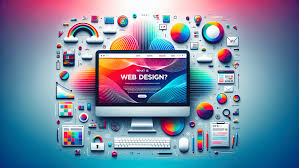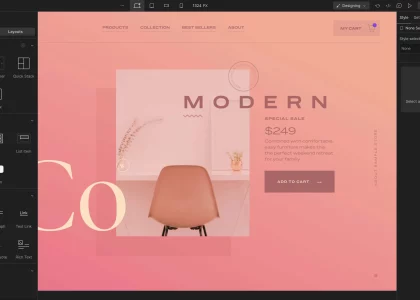In today’s digital age, a compelling online presence is essential for businesses, organizations, and individuals alike. At the heart of this online presence lies web design – the art and science of creating visually stunning, user-friendly websites that captivate audiences and drive results. In this comprehensive guide, we’ll explore the fundamentals of web design, from its core principles and best practices to emerging trends and the future of digital design.
Understanding the Basics
At its core, web design is the process of conceptualizing, planning, and building websites to deliver a seamless user experience. It encompasses a wide range of disciplines, including graphic design, interface design, user experience (UX) design, and search engine optimization (SEO). Effective web design strikes a delicate balance between aesthetics and functionality, creating visually appealing websites that are easy to navigate and intuitive to use.
Key Principles of Web Design
Several key principles underpin successful web design:
- User-Centric Design: A user-centric approach lies at the heart of effective web design. Understanding the needs, preferences, and behaviors of your target audience is essential for creating websites that resonate with users and meet their expectations.
- Responsive Design: With the proliferation of mobile devices, responsive design has become indispensable. Responsive websites adapt seamlessly to different screen sizes and resolutions, ensuring a consistent user experience across desktops, laptops, tablets, and smartphones.
- Accessibility: Web design should be inclusive and accessible to users of all abilities. Implementing accessibility features such as alt text for images, keyboard navigation, and semantic HTML markup ensures that websites can be easily accessed and navigated by individuals with disabilities.
- Visual Hierarchy: Establishing a clear visual hierarchy is essential for guiding users’ attention and prioritizing content. Effective use of typography, color, contrast, and whitespace helps create a hierarchy of information, making it easier for users to scan and digest content.
- Performance Optimization: Website performance plays a crucial role in user satisfaction and search engine rankings. Optimizing page load times, minimizing server requests, and optimizing images and multimedia content are key strategies for improving website performance.
Best Practices
Incorporating best practices into your web design process can help ensure the success of your website:
- Plan and Research: Start by defining your goals, target audience, and user personas. Conduct research to gain insights into industry trends, competitor websites, and user preferences.
- Wireframing and Prototyping: Create wireframes and prototypes to visualize the layout, structure, and functionality of your website before diving into the design phase. This iterative process allows for early feedback and refinement of design concepts.
- Visual Design: Pay careful attention to visual design elements such as color scheme, typography, imagery, and branding. Create a cohesive visual identity that reflects your brand personality and resonates with your target audience.
- Content Strategy: Develop a content strategy that aligns with your business objectives and user needs. Create compelling, engaging content that communicates your message effectively and drives user engagement.
- Usability Testing: Conduct usability testing to evaluate the effectiveness and usability of your website. Solicit feedback from real users to identify pain points, usability issues, and areas for improvement.
Emerging Trends
The field of web design is constantly evolving, driven by technological advancements, changing user behaviors, and shifting design trends. Some of the emerging trends shaping the future of web design include:
- Minimalism: Minimalist design continues to gain popularity, with a focus on clean layouts, simple typography, and ample whitespace. Minimalist websites offer a streamlined user experience and prioritize content over clutter.
- Dark Mode: Dark mode design, which features dark color schemes and low-light interfaces, has become increasingly prevalent. Dark mode enhances readability in low-light conditions, reduces eye strain, and adds a touch of sophistication to website designs.
- Microinteractions: Microinteractions are subtle animations and interactive elements that enhance user engagement and delight. From animated buttons and hover effects to scrolling animations and loading transitions, microinteractions add personality and interactivity to websites.
- Voice User Interfaces (VUI): With the rise of voice-enabled devices and virtual assistants, voice user interfaces (VUI) are becoming increasingly important in web design. Designing for voice interactions requires a focus on conversational design, natural language processing, and accessibility.
- Augmented Reality (AR) and Virtual Reality (VR): AR and VR technologies offer exciting possibilities for immersive web experiences. From virtual product tours and interactive 3D models to augmented reality overlays and virtual environments, AR and VR are transforming the way users engage with web content.
The Future of Web Design
As we look to the future, the landscape of web design is poised for further innovation and evolution. Emerging technologies such as artificial intelligence (AI), machine learning, and the Internet of Things (IoT) will continue to shape the way we design and interact with websites. Personalization and customization will play an increasingly important role, with websites adapting dynamically to individual user preferences and behaviors.
In conclusion, web design is a dynamic and multifaceted discipline that combines creativity, technical expertise, and user-centered principles to create compelling online experiences. By understanding the fundamentals of web design, incorporating best practices, and embracing emerging trends, designers can create websites that captivate audiences, drive engagement, and deliver tangible results. Whether you’re a seasoned designer or just starting out, embracing the principles and practices of web design can unlock the power of digital creativity and innovation.





